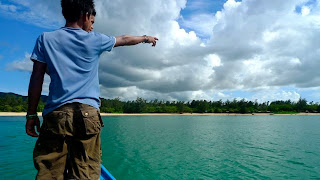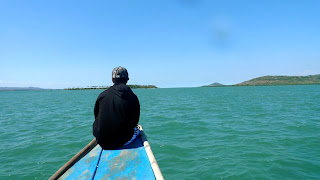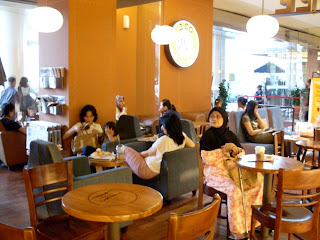Guilin: Romantic City
I arrived in cold Guilin with high energy. I rushed to the immigration and grabbed my backpack on the luggage belt. I looked around for a public bus to the city center, but saw nothing but a small mini bus in front of the airport entrance. I approached a girl beside the bus and asked if this could take me to Guilin. She said, "Yes, Guilin". So I boarded the small bus which looked more like a huge van, and waited for it to fill up. I arrived in Guilin City after an hour, and we were dropped off in front of a hotel. I didn't know where I was, so I called Lakeside Inn for them to instruct the taxi driver to take me to their guesthouse. And this is something I did in every destination. I have listed at least 3 accommodations on my phone with their numbers, and just decided where to stay when I get in the taxi. Call it a random process, that involves luck.

The Guilin Lakeside Inn turned out to be a great choice. It was located between the public square and Fir Lake along a major road. There were restaurants and stores all around.

The staff greeted me with enthusiasm, and led me directly to a room. The room was cozy as it its floors and walls were all wood. The bathroom was huge and also had a glass window, sans the electronic curtain. For only 120 RMB a night (P950), it was cheap luxury.

I was so hungry, so I looked for the nearest fast food, which turned out to be KFC. They had this shrimp and crab fried dumpling that came with my chicken. It was cold outside, around 5 degrees, and the wind was blowing strong. I went back to the inn and asked what I could do for an afternoon. Guilin and its surrounding towns are known for its landscape, the thousands of limestone karst formations jutting out of the green fields. It was a surreal picture, as the fog and mist made the landscape more dramatic. I decided to go to the Reed Flute Cave, which was just a 15 minutes away via public bus. I waited for bus number 4A in a stop near the inn. The wind was getting stronger, so I was waiting in the cold. At last, the bus arrived after around 8 minutes. I paid 1 yuan, the cost of public city bus anywhere in China.

There were 2 Westerners in the bus as well, and I assumed they were also going to the cave. I followed them when they got off, and there was the sign leading to the Reed Flute Cave ticket office. The entrance costs 90RMB (P600). I thought it was expensive for a cave. As I walked to the entrance, there were dedications by famous state leaders who have visited the caves since the 1970s.

I entered the caves with a group of Chinese tourists. I hustled to get ahead of them. As soon as I got passed them, I was immediately taken aback. The caves were huge, high and spectacular. Lights of different colors illuminated the chambers, that made you feel you were in a magical fairy land.

There were black still ponds that reflected the illuminated rocks, making the scenery grander. I arrived in the biggest chamber where lights changed colors every now and then. The place may have been turned into a theme park and museum of sorts, with the paved, stone cemented pathways, shimmering lights and ambient music, but the natural beauty was still present. I really felt I was in outer space or something. After a few minutes, the lights slowly faded out, and smoke filled the place. There was a 3-minute light show that occurred in the biggest chamber. At that time, I was amazed at the creativity of the Chinese.

I went out the caves, and explored the surroundings. There were pathways to viewpoints and pagodas. I decided to go uphill to get a bird's eye view. It was cold, and I took more than 300 steps up. Guilin was seen from afar, but the countryside was calling.

After a few minutes of rest, I went down and looked for a bus going back the city center. On the way, I passed by this small dried up lake, with bamboo rafts and bridges. I was truly in a different place, far different from what I usually see in South East Asia, but still familiar in a way. I boarded the bus, dropped 1 yuan and sat down satisfied with my first tourist attraction.

I got off near the inn and walked around. I went tot the direction of the public square. There were more people on the streets this time, probably because work was ending. The receptionist told me that 70% of the population worked in a tourism related job, so Guilin is pretty much dependent on the yuans of its visitors.

I found Guilin to be clean and organized. There were shopping opportunities all around. No malls, but shopping squares and streets. There were pedestrian streets that were lined up with branded stores and restaurants. There were significantly more Chinese tourists again, than Westerners. It was a nice city to walk on. I just let my inner map guide me, and I found myself on the banks of the Li River. It was dried up, because of the season. I saw the Elephant Trunk Hill, but there was no water on its base, so I didn't see the view that was printed on all postcards. I passed a lot of parks, and ended up in the lake that was near my inn.

It was already evening, and Guilin was transformed. Like the Reed Flute Cave, colored lights burst into the entire city, painting the trees, waterways, bridges and streets. I was walking along the banks of the lake, and it reminded me of a laid back European city. There was romance in the cold air, as lovers came out admiring the views of the lake. And it was a romantic sight to behold, this city that is Guilin.


The Guilin Lakeside Inn turned out to be a great choice. It was located between the public square and Fir Lake along a major road. There were restaurants and stores all around.

The staff greeted me with enthusiasm, and led me directly to a room. The room was cozy as it its floors and walls were all wood. The bathroom was huge and also had a glass window, sans the electronic curtain. For only 120 RMB a night (P950), it was cheap luxury.

I was so hungry, so I looked for the nearest fast food, which turned out to be KFC. They had this shrimp and crab fried dumpling that came with my chicken. It was cold outside, around 5 degrees, and the wind was blowing strong. I went back to the inn and asked what I could do for an afternoon. Guilin and its surrounding towns are known for its landscape, the thousands of limestone karst formations jutting out of the green fields. It was a surreal picture, as the fog and mist made the landscape more dramatic. I decided to go to the Reed Flute Cave, which was just a 15 minutes away via public bus. I waited for bus number 4A in a stop near the inn. The wind was getting stronger, so I was waiting in the cold. At last, the bus arrived after around 8 minutes. I paid 1 yuan, the cost of public city bus anywhere in China.

There were 2 Westerners in the bus as well, and I assumed they were also going to the cave. I followed them when they got off, and there was the sign leading to the Reed Flute Cave ticket office. The entrance costs 90RMB (P600). I thought it was expensive for a cave. As I walked to the entrance, there were dedications by famous state leaders who have visited the caves since the 1970s.

I entered the caves with a group of Chinese tourists. I hustled to get ahead of them. As soon as I got passed them, I was immediately taken aback. The caves were huge, high and spectacular. Lights of different colors illuminated the chambers, that made you feel you were in a magical fairy land.

There were black still ponds that reflected the illuminated rocks, making the scenery grander. I arrived in the biggest chamber where lights changed colors every now and then. The place may have been turned into a theme park and museum of sorts, with the paved, stone cemented pathways, shimmering lights and ambient music, but the natural beauty was still present. I really felt I was in outer space or something. After a few minutes, the lights slowly faded out, and smoke filled the place. There was a 3-minute light show that occurred in the biggest chamber. At that time, I was amazed at the creativity of the Chinese.

I went out the caves, and explored the surroundings. There were pathways to viewpoints and pagodas. I decided to go uphill to get a bird's eye view. It was cold, and I took more than 300 steps up. Guilin was seen from afar, but the countryside was calling.

After a few minutes of rest, I went down and looked for a bus going back the city center. On the way, I passed by this small dried up lake, with bamboo rafts and bridges. I was truly in a different place, far different from what I usually see in South East Asia, but still familiar in a way. I boarded the bus, dropped 1 yuan and sat down satisfied with my first tourist attraction.

I got off near the inn and walked around. I went tot the direction of the public square. There were more people on the streets this time, probably because work was ending. The receptionist told me that 70% of the population worked in a tourism related job, so Guilin is pretty much dependent on the yuans of its visitors.

I found Guilin to be clean and organized. There were shopping opportunities all around. No malls, but shopping squares and streets. There were pedestrian streets that were lined up with branded stores and restaurants. There were significantly more Chinese tourists again, than Westerners. It was a nice city to walk on. I just let my inner map guide me, and I found myself on the banks of the Li River. It was dried up, because of the season. I saw the Elephant Trunk Hill, but there was no water on its base, so I didn't see the view that was printed on all postcards. I passed a lot of parks, and ended up in the lake that was near my inn.

It was already evening, and Guilin was transformed. Like the Reed Flute Cave, colored lights burst into the entire city, painting the trees, waterways, bridges and streets. I was walking along the banks of the lake, and it reminded me of a laid back European city. There was romance in the cold air, as lovers came out admiring the views of the lake. And it was a romantic sight to behold, this city that is Guilin.




Comments
Post a Comment